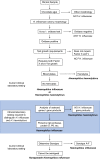Insights on persistent airway infection by non-typeable Haemophilus influenzae in chronic obstructive pulmonary disease
- PMID: 28449098
- PMCID: PMC5437125
- DOI: 10.1093/femspd/ftx042
Insights on persistent airway infection by non-typeable Haemophilus influenzae in chronic obstructive pulmonary disease
Abstract
Non-typeable Haemophilus influenzae (NTHi) is the most common bacterial cause of infection of the lower airways in adults with chronic obstructive pulmonary disease (COPD). Infection of the COPD airways causes acute exacerbations, resulting in substantial morbidity and mortality. NTHi has evolved multiple mechanisms to establish infection in the hostile environment of the COPD airways, allowing the pathogen to persist in the airways for months to years. Persistent infection of the COPD airways contributes to chronic airway inflammation that increases symptoms and accelerates the progressive loss of pulmonary function, which is a hallmark of the disease. Persistence mechanisms of NTHi include the expression of multiple redundant adhesins that mediate binding to host cellular and extracellular matrix components. NTHi evades host immune recognition and clearance by invading host epithelial cells, forming biofilms, altering gene expression and displaying surface antigenic variation. NTHi also binds host serum factors that confer serum resistance. Here we discuss the burden of COPD and the role of NTHi infections in the course of the disease. We provide an overview of NTHi mechanisms of persistence that allow the pathogen to establish a niche in the hostile COPD airways.
Keywords: chronic obstructive pulmonary disease; immune evasion; mechanisms of persistence; non-typeable Haemophilus influenzae; persistent infection.
© FEMS 2017. All rights reserved. For permissions, please e-mail: journals.permissions@oup.com.
Figures



Similar articles
-
Adaptation of Nontypeable Haemophilus influenzae in Human Airways in COPD: Genome Rearrangements and Modulation of Expression of HMW1 and HMW2.mBio. 2023 Apr 25;14(2):e0014023. doi: 10.1128/mbio.00140-23. Epub 2023 Mar 16. mBio. 2023. PMID: 36927061 Free PMC article.
-
The Role of Non-Typeable Haemophilus influenzae Biofilms in Chronic Obstructive Pulmonary Disease.Front Cell Infect Microbiol. 2021 Aug 4;11:720742. doi: 10.3389/fcimb.2021.720742. eCollection 2021. Front Cell Infect Microbiol. 2021. PMID: 34422683 Free PMC article. Review.
-
The adhesins of non-typeable Haemophilus influenzae.Expert Rev Anti Infect Ther. 2018 Mar;16(3):187-196. doi: 10.1080/14787210.2018.1438263. Epub 2018 Feb 21. Expert Rev Anti Infect Ther. 2018. PMID: 29415569 Review.
-
The Interplay Between Immune Response and Bacterial Infection in COPD: Focus Upon Non-typeable Haemophilus influenzae.Front Immunol. 2018 Nov 5;9:2530. doi: 10.3389/fimmu.2018.02530. eCollection 2018. Front Immunol. 2018. PMID: 30455693 Free PMC article. Review.
-
The Pulmonary Extracellular Matrix Is a Bactericidal Barrier Against Haemophilus influenzae in Chronic Obstructive Pulmonary Disease (COPD): Implications for an in vivo Innate Host Defense Function of Collagen VI.Front Immunol. 2018 Aug 31;9:1988. doi: 10.3389/fimmu.2018.01988. eCollection 2018. Front Immunol. 2018. PMID: 30233584 Free PMC article.
Cited by
-
An integrative network-based approach to identify driving gene communities in chronic obstructive pulmonary disease.NPJ Syst Biol Appl. 2024 Oct 26;10(1):125. doi: 10.1038/s41540-024-00425-6. NPJ Syst Biol Appl. 2024. PMID: 39461973 Free PMC article.
-
Non-typeable Haemophilus influenzae airways infection: the next treatable trait in asthma?Eur Respir Rev. 2022 Sep 20;31(165):220008. doi: 10.1183/16000617.0008-2022. Print 2022 Sep 30. Eur Respir Rev. 2022. PMID: 36130784 Free PMC article. Review.
-
Antagonistic Pleiotropy in the Bifunctional Surface Protein FadL (OmpP1) during Adaptation of Haemophilus influenzae to Chronic Lung Infection Associated with Chronic Obstructive Pulmonary Disease.mBio. 2018 Sep 25;9(5):e01176-18. doi: 10.1128/mBio.01176-18. mBio. 2018. PMID: 30254117 Free PMC article.
-
Nontypeable Haemophilus influenzae Redox Recycling of Protein Thiols Promotes Resistance to Oxidative Killing and Bacterial Survival in Biofilms in a Smoke-Related Infection Model.mSphere. 2022 Feb 23;7(1):e0084721. doi: 10.1128/msphere.00847-21. Epub 2022 Jan 19. mSphere. 2022. PMID: 35044805 Free PMC article.
-
Development and multimodal characterization of an elastase-induced emphysema mouse disease model for the COPD frequent bacterial exacerbator phenotype.Virulence. 2021 Dec;12(1):1672-1688. doi: 10.1080/21505594.2021.1937883. Virulence. 2021. PMID: 34252004 Free PMC article.
References
-
- Abe Y, Murphy TF, Sethi S et al. . Lymphocyte proliferative response to P6 of Haemophilus influenzae is associated with relative protection from exacerbations of chronic obstructive pulmonary disease. Am J Resp Crit Care 2002;165:967–71. - PubMed
-
- Adamson J, Haswell LE, Phillips G et al. . In Vitro Models of Chronic Obstructive Pulmonary Disease (COPD). In Martin-Loeches Ignacio, (ed.), Bronchitis (Rijeka: InTech; ), Ch. 03. 2011.
-
- Ahren IL, Eriksson E, Egesten A et al. . Nontypeable Haemophilus influenzae activates human eosinophils through beta-glucan receptors. Am J Resp Cell Mol Biol 2003;29:598–605. - PubMed
-
- Ahren IL, Janson H, Forsgren A et al. . Protein D expression promotes the adherence and internalization of non-typeable Haemophilus influenzae into human monocytic cells. Microb Pathog 2001a;31:151–8. - PubMed
Publication types
MeSH terms
Grants and funding
LinkOut - more resources
Full Text Sources
Other Literature Sources
Medical

